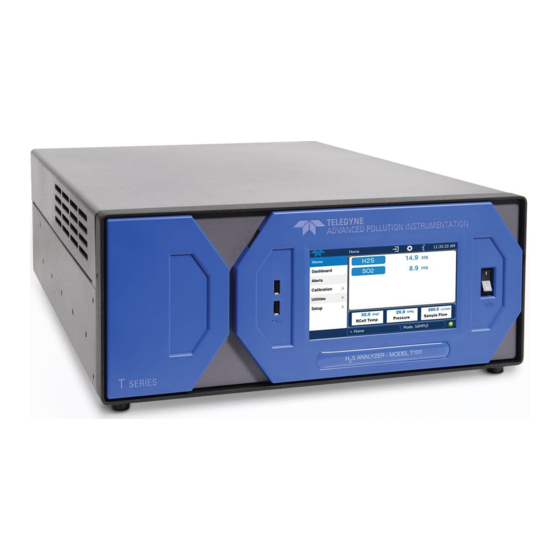
Teledyne T101 Manuals
Manuals and User Guides for Teledyne T101. We have 1 Teledyne T101 manual available for free PDF download: Operation Manual
Teledyne T101 Operation Manual (375 pages)
UV FLUORESCENCE H2S ANALYZER
Brand: Teledyne
|
Category: Measuring Instruments
|
Size: 7 MB
Table of Contents
-
Introduction
23 -
-
-
Front Panel30
-
Rear Panel34
-
-
-
-
-
Sample Mode62
-
Setup Mode68
-
-
Signal I/O87
-
-
Optic Test101
-
Electrical Test102
-
Lamp Calibration103
-
Flow Calibration105
-
-
Instrument ID107
-
Configuration111
-
MODBUS Set up123
-
COM Port Testing128
-
-
-
DAS Structure129
-
DAS Channels129
-
DAS Parameters130
-
-
-
Trigger Events137
-
Compact Report143
-
Report Function143
-
Starting Date143
-
HOLDOFF Feature145
-
-
Remote Operation
147-
-
Status Outputs147
-
Control Inputs149
-
-
Command Syntax152
-
Data Types152
-
Status Reporting153
-
-
-
-
-
-
Record Keeping194
-
-
Precision Check198
-
References200
-
-
-
-
-
Status Leds222
-
-
High Flow225
-
-
DC Power Supply231
-
I 2 C Bus232
-
Relay Board232
-
Motherboard233
-
A/D Functions233
-
Status Outputs234
-
Control Inputs234
-
-
Cpu234
-
Communication235
-
PMT Sensor236
-
-
Sample Pressure238
-
-
IZS Option238
-
Box Temperature239
-
PMT Temperature239
-
-
-
-
UV Source Lamp253
-
The PMT254
-
Optical Filters255
-
Optical Lenses256
-
-
Dilution258
-
Light Pollution258
-
-
-
Sample Gas Flow260
-
SO Scrubber263
-
-
-
Cpu267
-
Flash Chip267
-
PMT Preamplifier271
-
Relay Board273
-
Heater Control273
-
Valve Control273
-
-
Motherboard275
-
Sensor Inputs275
-
Analog Outputs276
-
C Data Bus277
-
Power up Circuit277
-
-
-
-
General Rules286
-
-
-
Table 3-8. H308
-
Advertisement
Advertisement
